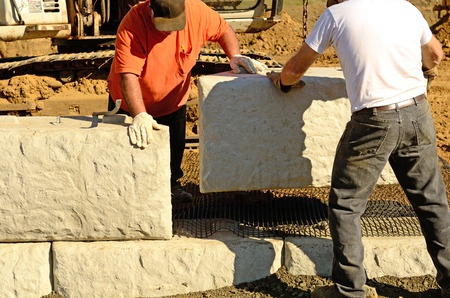The benefits of retaining walls and your property

Many properties, specifically those with front, rear, or substantially sizable side yards have retaining walls built into them. Lots of businesses and schools also have retaining walls as these are commonly built on slopes or with foundational sloping properties that could otherwise compromise the integrity of said property.
Types of retaining walls
Natural Stone—Although the most expensive, these are not only the most appealing to the eye, but also the most solid foundation for your property and the surrounding elements in terms of stability. Costing nearly $25 per sq. ft., this is definitely a long-term investment of your money. In many cases, the wall may very well prove to otherwise effectively utilize rainwater to support your garden or agricultural properties surrounding your house. They also of course, are very pleasing to the eye and come in many customizable unique patterns.
Concrete Blocks—While not as appealing as natural stones, concrete blocks provide a very stable foundation and countermeasure against flooding and support adequate long-term balance and stability for your house, and the dynamics of a unique incline before, on, or after your property. This style is common, as it gives the most ‘modern’ look, and also practical in price at only $20 per sq. foot.
Timber blocks—Although the cheapest, these are not guaranteed to last long-term as weathering can degrade the integrity of it’s foundation, and even in turn jeopardizes the stability of your home. However, costing only $15 per sq. foot, this is a common choice. Unfortunately, this is commonly due to a lack of knowledge or education in professional landscaping, and exhibit A, as to the importance of consulting with experienced professionals regarding the development of applying retaining walls and how it could benefit your property. While some might desire this look, if you can afford the maintenance, and ensure the proper irrigation system is installed into the retaining wall, this may very well be the choice for you.
Don’t be tempted to use the same company you rely on for landscaping, for mapping out and installing or building a retaining wall within your property. In fact, shop around, conduct your research, and try to select a contractor or agency that has a lengthy record of positive projects, feedback, certification, and can demonstrate past work to you in a practical manner.
A few common reasons individuals install retaining walls is due to sliding hills or downhill erosion within their property, specifically in close proximity to their home or in it’s direct path. Because of this, installing a retaining wall has a strong potential to maintain the balance, as well as defend from preventing or rerouting flooding and other natural disasters with a firm system. Be careful, and ensure the professionals you hire take into consideration the local weather patterns in your area, such as flooding, common temperatures, and any other significant environmental elements that could otherwise interfere, benefit, or cause more harm than good in it’s creation or building technique.
Image credit: Tracy Fox
